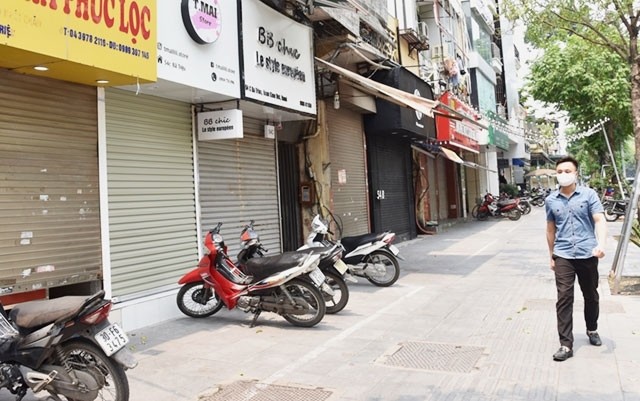Q: How has COVID-19 pandemic affected the Vietnamese economy in the first quarter of this year and which sectors were most affected by the pandemic?
A: The pandemic has caused most industries to slow down in addition to increasing the unemployment rate in the first quarter of 2020. Vietnam’s GDP is estimated to have expanded by 3.82% in the first quarter of this year, the lowest increase since 2011 with declines in three key sectors including industry and construction, agro-forestry and fishery industry and the service industry. The sectors who have suffered the highest losses include aviation, tourism, textiles, and wood exports.
In addition, the Vietnam Manufacturing Purchasing Managers’ Index (PMI) fell to 49 in February 2020, the first drop in manufacturing activity over four years, signaling a decline in orders and exports.
A survey on business trends in the first quarter conducted by the GSO showed that 42% of enterprises said that they faced difficulties in doing business compared to the previous quarter while the rate was only 17% in the same period in 2019. Meanwhile, the number of enterprises registered to have temporarily suspended operations rose by 26% over the same period last year.
The country’s total import-export revenue also fell by 0.7% in the reviewed period while the consumer price index (CPI) soared by 5.56%, the highest level over the same period in the past few years.
Amidst the outbreak of the COVDI-19 pandemic across the world and the rapid and serious decline of the world economy, it can be affirmed that Vietnam's GDP growth is at a rather good level compared to others in the region and in the world.
Q: In this context, which sectors are the driving forces for economic growth and are the highlights in production and business activity?
A: The manufacturing industry has expanded by 7.12% in the period, though not huge, it still plays a key role in the economic growth. Despite many difficulties, several key industries remain highlights of the economy with good growth rates. Specifically, the production of medicines and pharmaceuticals rose by 28.3%, the petroleum processing industry increased by 22.4%, and the production of electronics, computers and optical products went up by 4%. The result was mainly attributed to the Samsung’s launch of their new Galaxy S20 and the relocation of a plant from the Republic of Korea to Hai Phong, helping to increase the production and export of electronic products and components.
Q: Public investment has been recognised as an important driving force for Vietnam's economic growth but the slow disbursement of public investment over the past few years has limited its contribution to GDP growth. In the current context, what solutions should be implemented to make public investment able to fuel growth?
A: Disbursement of public investment capital in the first quarter has seen a positive change which reached 13.2% of the year’s plan (the same period last year reached 12.7%). The implementation of public investment is an effective solution to boost economic growth. According to our calculations, a 1% increase in public investment contributes 0.06 percentage points to GDP growth.
We usually disburse about 92% to 93% of the planned budget each year and if 100% of public investment capital can be disbursed in 2020, it will contribute an additional 0.42 percentage point to GDP.
Therefore, it is necessary to focus on resolving bottlenecks on public investment to promote growth in the forthcoming quarters. The Government has made reforms regarding administration to accelerate the disbursement of public investment such as the early allocation and one-off allocation of capital for ministries and localities to help them actively pump it into the economy. In addition, the effectiveness of the Investment Law (amended) has contributed to simplifying investment procedures and removing obstacles regarding public investment. These solutions should be promoted in the future.
Q: If the pandemic continues, price increases for some commodities may occur as happened for medical face masks and pork. The inflation in the first quarter was quite high, what solutions should the government devise to keep inflation below 4% for the whole year?
A: Average CPI in the first quarter of this year went up due to the increase in pork prices since December. The pressure on inflation is quite large because of the erratic changes of prices of gasoline and the price increases in medical and educational services as scheduled. To calm inflation down to 4% as set by the National Assembly can be difficult. It is important is to focus on the prevention and control of African swine fever and the repopulation of pig herds to pull down live hog prices.
Q: In your opinion, what are the solutions for growth in 2020 and should socio-economic development targets be adjusted to suit actual developments?
A: The achievement of a 6.8% economic growth rate in 2020 is a big challenge, requiring a huge effort by the Government, businesses and people. I think that amidst the serious impact of the COVID-19 pandemic on a global scale, achieving a positive growth would be a proud achievement. It is not necessary to adjust the growth target to fulfill it every year.
Besides efforts to control the pandemic, the government should focus on supporting the business community, especially small and medium-sized enterprises and seriously affected industries such as transportation and tourism. Administrative procedures regarding land and public investment need to be streamlined in order to speed up progress of delayed projects.
In addition, monetary policy, fiscal policy, interest rates, and exchange rates should be regulated flexibly in accordance with the developments of domestic and international markets.
Thank you very much!
















